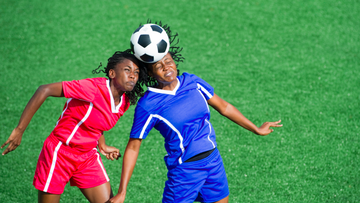Goalkeepers don’t suffer the exact same injuries their field counterparts do, but they’re more prone to some unique (and painful) ones. Shoulder injuries are the kryptonite for many goalkeepers.
The acrobatic saves goalkeepers make can lead to shoulder sprains and fractures. These injuries can leave them sidelined for weeks. This post will examine how shoulder injuries occur, and what goalkeepers can do to reduce injury risk.
Shoulder Anatomy/Injury Risk
You’re about to learn some interesting things about your shoulder. Perhaps, you didn’t know this, but your shoulder is the most mobile joint in your body. It can rotate and twist in ways you wouldn’t believe (just look at contortionists).
With that said, all that mobility makes shoulders prone to instability and injury (more on this later). Fortunately, we have rotator cuffs to hold them in place. Your rotator cuff consists of four separate muscles that converge together, operating as one. This ingenious design allows these four muscles to contract simultaneously. It also keeps the arm bone locked against a part of the shoulder blade called the glenoid, giving it more stability.
That same rotator cuff design allows goalkeepers to do superhuman feats of athletics. Whether it's a diving block, an acrobatic catch, or a powerful throw, the rotator cuff makes this all possible.
But like any other joint, your rotator cuff has limits.
Your Cuffs Got it Rough
- Goalkeepers often block or catch 15 oz balls traveling at 80 mph from 12 yards away. This contact can unleash an equivalent of 3 to 4 times your body weight on your rotator cuff in under half a second. That’s an incredible amount of force.
- This force amounts to more than 2,500 ft-lb per second placed on the shoulders for a 150 lb goalkeeper.
Again, this is a tremendous amount of force. And your poor rotator cuff has to (excuse the pun) shoulder all that force. It usually does a good job of it, but it’s not indestructible. Constant wear-and-tear from blocking shots can (and often does) injury the rotator cuff. And a damaged rotator cuff is no fun to deal with.
Common Shoulder Injuries for Goalkeepers
- Nagging shoulder pain
- Bursitis
- Torn rotator cuff tendons
- Capsulitis
- Fractured shoulders
Goalkeepers may read this and think to themselves, “When will this happen to me?”.
Yet, the reality is this: even if you do have a risk of getting a shoulder injury, you can reduce it significantly.
How Goalkeepers Can Prevent Shoulder Injuries
There are a few ways to keep your shoulders safer from injury. The two most important strategies are proper conditioning and wearing soccer protective gear. Doing both will reduce the strain that goalkeeping exerts on the shoulder joints.
Rotator Cuff Conditioning
Remember, your rotator cuff gives your shoulder the ability to pull off those magnificent blocks with finesse. But if a rotator cuff suffers from instability, injuries will follow.
So you need to strengthen those rotator cuffs. The interesting thing about shoulder injuries is that weakness is usually not the problem - poor motor control is the cause. That’s why traditional weight training programs to strengthen them won’t do much.
The goal of rotator cuff training should be stabilization of the joint.
That may involve exercises such as:
- doorway stretch
- side-lying external rotation
- high-to-low rows
- reverse fly
- lawn mower pull
These exercises emphasize stability and an efficient range of motion.
Impact Protection
Structural weaknesses and overuse are common causes of shoulder/rotator cuff injuries. But, falls and blunt traumas can lead to injury as well. Goalkeepers dive...a lot. That may mean falling in a compromising position that triggers a rotator cuff injury. And let’s be honest - dives and falls are unavoidable.
You can reduce the impact of falls with protective gear. That includes tops that come with padding/shielding that reduce the force of blunt trauma. An example of this is a padded goalkeeper jersey.
Our line of BodyShield padded goalkeeper jerseys contain materials that reduce impact forces by up to 90%. The shoulders of these jerseys feature anti-abrasion panels that act as a cushion when you fall.
A Chip Off Your Shoulder
Shoulder injuries affect goalkeepers more than other players on the field. Unfortunately, an injured shoulder can be a goalkeeper’s greatest weakness. Even just a bruised or achy shoulder can make routine blocks and catches difficult to make. And even though shoulder injuries are treatable, they can take weeks to heal.
Fortunately, with the right conditioning and protective gear (ie. padded goalkeeper jersey), you can avoid shoulder injuries the recovery process that comes with them. And with no shoulder pain, you can take your goalkeeping abilities to a higher level.
Are you looking for goalkeeper gear to protect yourself from shoulder injuries? Browse through our selection goalkeeper tops to find the equipment you need!

